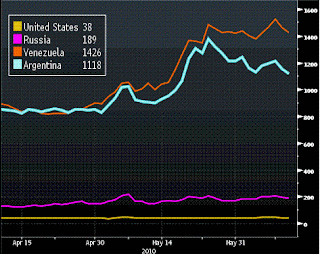Below I have featured the CDS rates for Greece, Venezuela, and Argentina. As you can see, both the South American countries' CDS rates have exploded recently. Greece's rate has come down after the bailout was passed, meaning expectations of default decreased. In case you are unfamiliar with a CDS I will give a brief description of an example. Basically a CDS is a financial instrument used to hedge a position against a company or in this case, country and the chance of default. For instance, say I enter into a CDS for $1 million for a pre-arranged "protection" time of 5-years with annual payments to Bank of Andrew. Lets also assume that I hold debt from a country called Risky. The rate of interest on the swap is shown below. The theory here is if a country is perceived to be risky and closer to default the rate will increase. This means that I pay, for Venezuela, 14.26% each year on the $1 million. If they do default, Bank A must pay me the notional amount. So for example if I were holding $750,000 in Venezuelan debt, I would have a net gain of $250,000 minus the annual interest payments. This is a simple explanation. The process is much more complex than I care to understand.
Most recently spreads have come in for Greece, due to the waning fears of default. However, no one seems to be paying attention to the South American countries of Venezuela and Argentina. Although both do have generally low debt to GDP ratios one may take this for granted and will thus be engulfed by a false sense of security. I do understand that Argentina has defaulted in the past thus making it a more risky investment.
The graph below compares those countries with the US and Russia. The graph speaks for itself.
Taking a peak at Venezuelan trade deficit, we can see the gap is the widening. This means they are importing more than they are exporting, which could a damper on GDP growth.
Looking at the yield on an issue of Argentinean debt, one must wonder why investors are requiring such a high yield. I do understand that there is global unrest but this yield is trading tremendously higher than Greece's, which is the so-called next country to default. And granted Argentina has defaulted in the past but they devalued their currency to boost exports and get their country out of debt.
All in all, it may be worthwhile to keep an eye on these 2 South American counties. Both are important, especially Argentina, to the global economy and any inherent possibility of default could potentially be harmful to the global recovery underway. This article attempts to serve as a point of view and is not in anyway a prediction future of either of these countries.
-Andrew





No comments:
Post a Comment